
Styphelia sieberi, commonly known as prickly beard-heath, is a species of flowering plant in the heath family Ericaceae and is endemic to south-eastern continental Australia. It is an erect, densely-branched shrub with oblong to more or less egg-shaped leaves with the narrower end towards the base, and white, tube-shaped flowers arranged singly in upper leaf axils.

Styphelia setigera is a species of flowering plant in the heath family Ericaceae and is endemic to eastern New South Wales. It is an erect to spreading shrub with lance-shaped to elliptic leaves, and white, tube-shaped flowers arranged singly or in pairs in leaf axils, forming a spike 10–16 mm (0.39–0.63 in) long.

Styphelia ericoides, commonly known as the pink beard-heath, is a species of flowering plant in the heath family Ericaceae and is endemic to south-eastern Australia. It is a slender shrub with oblong leaves, and white to pinkish, tube-shaped flowers.
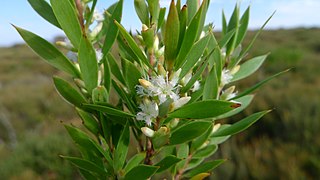
Styphelia esquamata, commonly known as the swamp beard-heath, is a species of flowering plant in the heath family Ericaceae and is endemic to south-eastern Australia. It is a slender shrub with mainly elliptic leaves, and short-lived white, tube-shaped flowers arranged singly or in pairs in upper leaf axils.
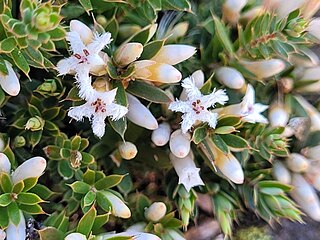
Styphelia nesophila, commonly known as sharp beard-heath, is a species of flowering plant in the heath family Ericaceae and is native to south-eastern Australia and New Zealand, where it is known as pātōtara, or dwarf mingimingi. It is a prickly, prostrate to trailing or low-growing shrub with egg-shaped leaves, and erect, tube-shaped white flowers usually arranged singly in leaf axils.
Styphelia tamminensis is a species of flowering plant in the heath family Ericaceae and is endemic to the southwest of Western Australia. It is a slender shrub with many branches, overlapping triangular to egg-shaped leaves and white, tube-shaped flower arranged singly in upper leaf axils.

Styphelia stomarrhena is a species of flowering plant in the family Ericaceae and is endemic to the south-west of Western Australia. It is a low, spreading or compact shrub with narrowly elliptic, sharply-pointed leaves and red, tube-shaped flowers usually arranged singly in leaf axils.

Styphelia appressa is a species of flowering plant in the heath family Ericaceae and is endemic to south-eastern New South Wales. It is a small, spreading to erect shrub with wiry stems, lance-shaped or narrowly egg-shaped to elliptic leaves and small white flowers.

Styphelia blakei is a species of flowering plant in the heath family Ericaceae and is endemic to inland southern Queensland. It is a sometimes prostrate, twiggy shrub with hairy branches, egg-shaped leaves with the narrower end towards the base, and small white flowers.

Styphelia clelandii, commonly known as Cleland's bearded-heath, is a species of flowering plant in the heath family Ericaceae and is endemic to the south-east of continental Australia. It is weak, open shrub with broadly egg-shaped leaves and white flowers arranged singly or in pairs in leaf axils near the ends of the branches.

Leucopogon collinus, commonly known as fringed beard-heath, is a species of flowering plant in the heath family Ericaceae and is endemic to south-eastern Australia. It is a slender, erect or spreading shrub with narrowly lance-shaped leaves, and white, tube-shaped, bearded flowers.
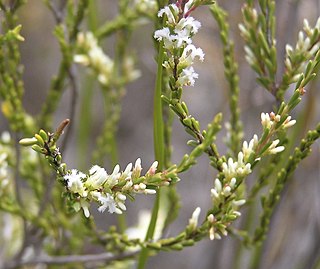
Styphelia corynocarpus is a flowering plant in the family Ericaceae and is endemic to the south-west of Western Australia. It is an erect, open shrub with narrowly egg-shaped to narrowly elliptic leaves, and white flowers arranged in groups of up to five in leaf axils.

Styphelia exolasia, commonly known as Woronora beard-heath, is a species of flowering plant in the heath family Ericaceae and is endemic to a small area of New South Wales. It is an erect shrub with oblong or elliptic leaves, and drooping, white, tube-shaped flowers.
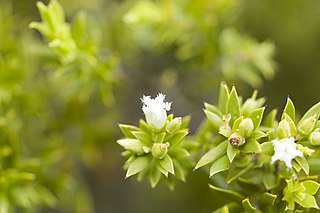
Styphelia leptospermoides is a species of flowering plant in the heath family Ericaceae and is endemic to eastern Australia. It is an erect, bushy shrub with elliptic to lance-shaped or oblong leaves, and white, tube-shaped flowers usually arranged singly in upper leaf axils.

Styphelia neoanglica, commonly known as New England beard heath, is a species of flowering plant in the heath family Ericaceae and is endemic to eastern Australia. It is an erect shrub with egg-shaped leaves, sometimes with the narrower end towards the base, and white, tube-shaped flowers arranged singly in leaf axils and bearded inside.

Styphelia riparia is a species of flowering plant in the heath family Ericaceae and is endemic to eastern Victoria in Australia. It is an erect shrub with narrowly elliptic to narrowly egg-shaped leaves, the narrower end towards the base, and white, tube-shaped flowers arranged in groups of 3 to 5 in leaf axils.

Styphelia rupicola is a species of flowering plant in the heath family Ericaceae and is endemic to Queensland. It is a shrub with linear leaves and white, tube-shaped flowers usually arranged singly in leaf axils.
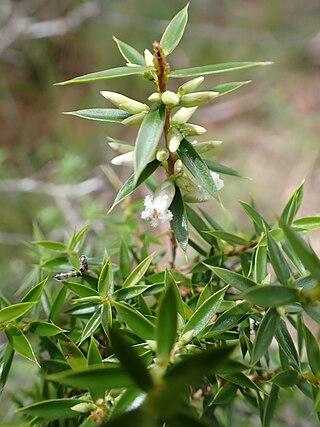
Styphelia trichostyla, commonly known as daphne heath, is a species of flowering plant in the heath family Ericaceae, and is endemic to eastern Australia. It is an erect to spreading shrub with elliptic to egg-shaped leaves, and white, tube-shaped flowers arranged singly or in groups of up to three in leaf axils.
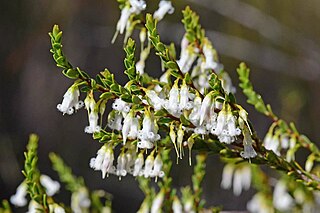
Styphelia woodsii, commonly known as nodding beard-heath, is a species of flowering plant in the heath family Ericaceae and is endemic to southern continental Australia. It is a slender shrub with more or less erect, egg-shaped leaves, and pendent white, tube-shaped flowers with densely bearded lobes.

Styphelia exarrhena, commonly known as desert styphelia, is a species of flowering plant in the heath family Ericaceae and is endemic to southern continental Australia. It is an erect shrub with erect or spreading egg-shaped leaves, and cream-coloured, tube-shaped flowers arranged singly or in pairs in upper leaf axils.




















